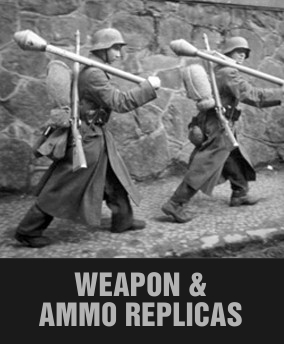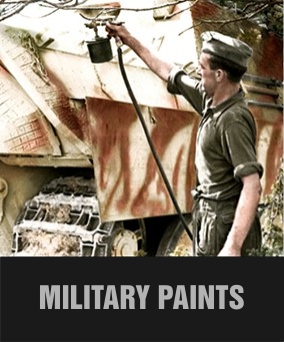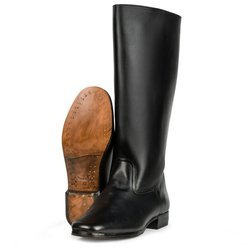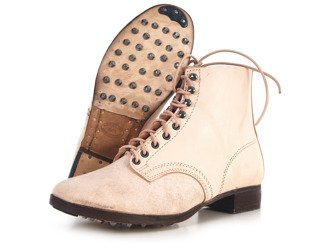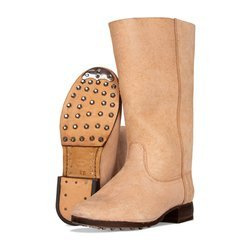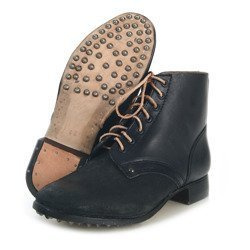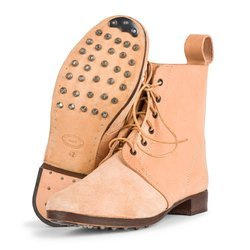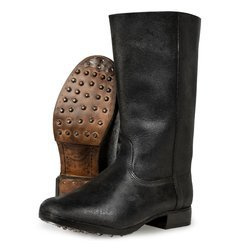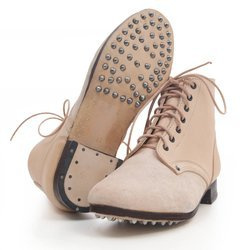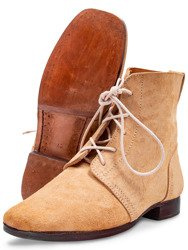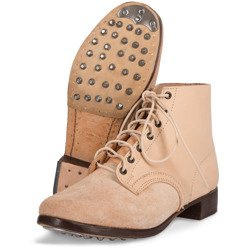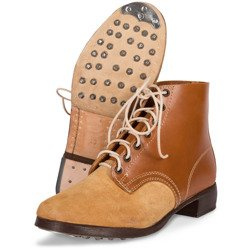Instruction for propper use (maintenance) of leather shoes
2019-07-10
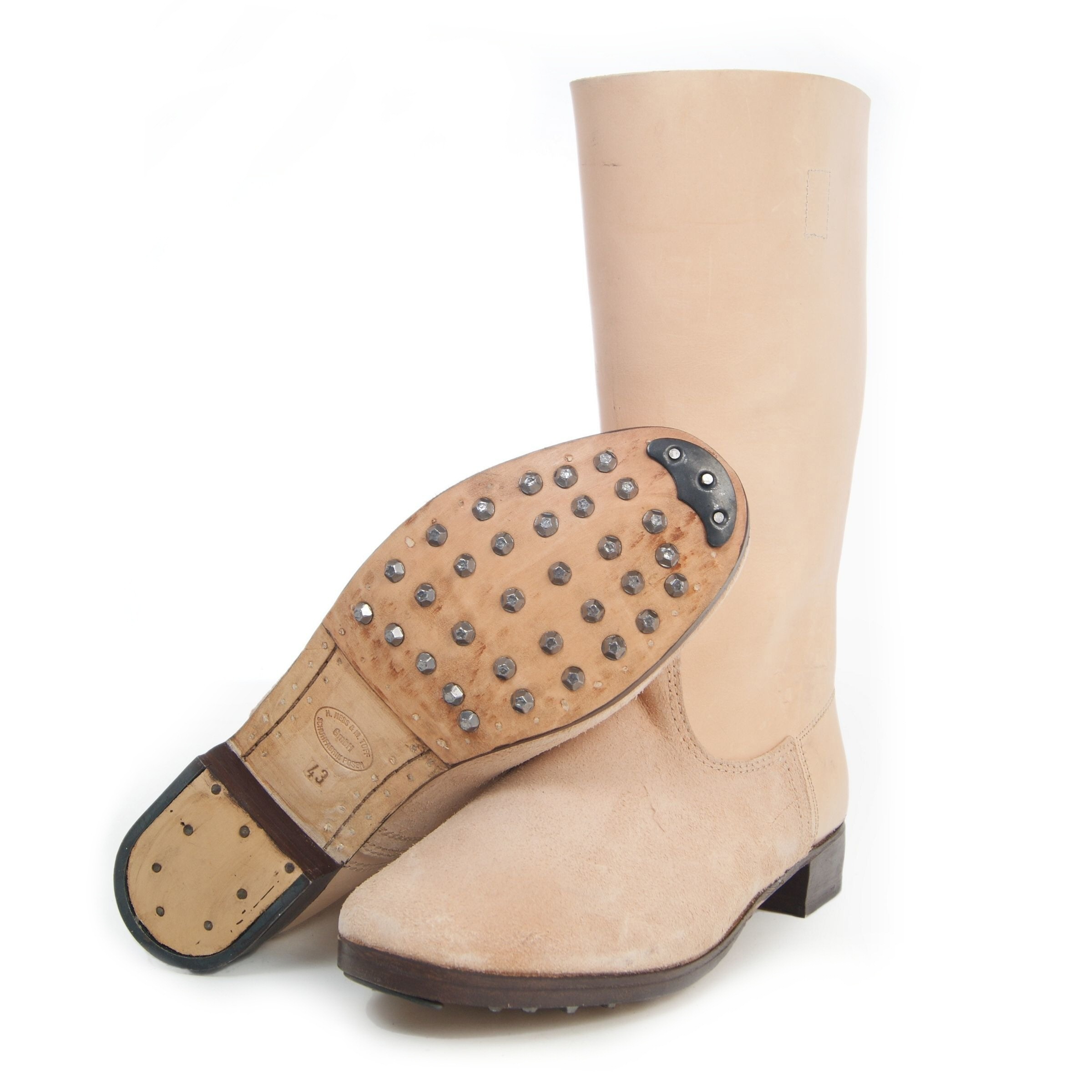
INSTRUCTION FOR PROPER USE (MAINTENANCE) OF LEATHER SHOES
Leather shoes made of natural, vegetable tanned leather require special maintenance. It is necessary to maintain the functional properties of footwear and ensure comfort of wearing shoes. Leather shoes from that era without appropriate maintenance can be quickly destroyed, while properly cared may serve for many years.
NOTE! All shoes from our saddlery workshop are covered by a warranty, lack of proper maintenance can result in its loss!
Below is a brief instruction how to proper maintenance of leather footwear. We try to put it in such way that it should be understandable and easy to apply it at home. What si most importantly, shoes must be maintained before the first use.
1. First of all, You must prepare necessary ingredients, i.e. castor oil, linseed oil and anhydrous lanolin. You will need also smoe tools, i.e. shoe brush, dishcloths, containers, protective gloves, hair dryer.
2. Maintenance should be started by wiping and cleaning the shoes. Dust may accumulate on them during production, transport and storage. Particular attention should be paid to stitching and around the hobnails on the sole (if any).
3. Now we go to the sole. The leather on the sole is different from the other parts of the shoe, it has different properties - it is harder. We grease the sole with linseed oil, wait for the sole to "absorb" it, lubricate again and put the shoes away until all the oil is absorbed into the sole. Be careful that the oil does not get outside the sole, to other parts of the shoe.
4. The next stage is oiling. We lubricate whole shoe with castor oil - together with the sole (but on the sole goes much less, than on other parts of the boots). After the first lubrication we wait for the oil to dry, then we oil the shoes again, and again wait for drying. Once shoes are dried, make brushing.
5. In this step shoes can already be lubricate with anhydrous lanolin. Lanolin should be slightly heated, e.g. by placing it in a container inside boiling water, but in such a way that water does not get into the container. Or possibly in a metal box by using a lighter/heater. The shoes (without sole) must be lubricated with lanolin and then dryed by warm air, e.g. by using a hair dryer, this will cause the absorption of lanolin into the leather. Remember to use the dryer gently, blowing too close or too hot air can damage the leather. Excess lanolin should be removed with a brush/dishcloth.
6. Warm air does not have a very positive effect on the shoe leather, so after lanolin is "absorbed", it is worth to lubricating the shoes with castor oil once more and left them for dry.
7. The shoes prepared in this way are basically ready for use, but we strongly recommend polishing them with wax paste. If you prefer to preserve the natural color - use colorless paste with beeswax. Pay attention to places such as stitches and leather connections. To obtain a black or dark brown color you would have to use a dyed paste. The desired effect will only be possible after applying the colored paste several times. Regardless of whether you decide to color the shoes or leave them in a natural color - after polishing the shoes must be brushed.
8. As long as leather straps are attached to the shoes, which function as shoelaces, they should also be preserved with castor oil.
Shoes must also be periodically maintained, properly cleaned and cared after get wet - preferably after each use.
Falling out of nails is a natural process for shoes with leather soles, and depends on the conditions of use - You will loose much more of them on the pavement than in a field or forest. Proper maintenance of the sole will reduce this process, but will not completely eliminate it. The sole must be preserved so that it will be greased (protection against moisture) and hardened at the same time (vegetable oil, e.g. linseed oil, will harden the sole, which will make the nails stick better). Too poor maintenance, i.e. using too little linseed oil will result in a softening of the sole during use and a significant / accelerated loss of nails. Lack of proper maintenance of soles may also cause deformation of the soles leather in sensitive areas. On correct preserved sole, to check, you can perform a "nail test" - it should harden to such a degree that it becomes impossible to imprint the finger nail on the skin of the sole.
PERIODIC OILING: We recommend using castor oil - it must be applied to clean, not moist and not wet leather. The oil must be applied in such an amount that the leather will be unable to absorb more of the oil. After drying shoes should be thoroughly brushed.
CLEANING: Most of the dirt from leather shoes is removed with a brush, cloth and slightly warm water. Do not delay cleaning the footwear, clean it as soon as the appropriate opportunity arises. After cleansing, it is worth to lubricate the shoes with castor oil.
DRYING: A very important procedure for the care of leather shoes, which has a significant impact on its life time and wearing comfort. First of all, under no circumstances should the shoes be dried quickly. Placing them on a heater, using heat guns, dryers and this type of equipment is absolutely inadvisable. Dry, or rather too dryed leather becomes stiff like wood, is brittle and is generally not suitable for repair or regeneration. Do not abuse hygroscopic agents as they can also dry too much the leather. Excess moisture can be removed with a cloth. Shoes must be dried naturally, slowly, at room temperature. After drying, it is necessary to grease the footwear.
Below is a brief instruction how to proper maintenance of leather footwear. We try to put it in such way that it should be understandable and easy to apply it at home. What si most importantly, shoes must be maintained before the first use.
1. First of all, You must prepare necessary ingredients, i.e. castor oil, linseed oil and anhydrous lanolin. You will need also smoe tools, i.e. shoe brush, dishcloths, containers, protective gloves, hair dryer.
2. Maintenance should be started by wiping and cleaning the shoes. Dust may accumulate on them during production, transport and storage. Particular attention should be paid to stitching and around the hobnails on the sole (if any).
3. Now we go to the sole. The leather on the sole is different from the other parts of the shoe, it has different properties - it is harder. We grease the sole with linseed oil, wait for the sole to "absorb" it, lubricate again and put the shoes away until all the oil is absorbed into the sole. Be careful that the oil does not get outside the sole, to other parts of the shoe.
4. The next stage is oiling. We lubricate whole shoe with castor oil - together with the sole (but on the sole goes much less, than on other parts of the boots). After the first lubrication we wait for the oil to dry, then we oil the shoes again, and again wait for drying. Once shoes are dried, make brushing.
5. In this step shoes can already be lubricate with anhydrous lanolin. Lanolin should be slightly heated, e.g. by placing it in a container inside boiling water, but in such a way that water does not get into the container. Or possibly in a metal box by using a lighter/heater. The shoes (without sole) must be lubricated with lanolin and then dryed by warm air, e.g. by using a hair dryer, this will cause the absorption of lanolin into the leather. Remember to use the dryer gently, blowing too close or too hot air can damage the leather. Excess lanolin should be removed with a brush/dishcloth.
6. Warm air does not have a very positive effect on the shoe leather, so after lanolin is "absorbed", it is worth to lubricating the shoes with castor oil once more and left them for dry.
7. The shoes prepared in this way are basically ready for use, but we strongly recommend polishing them with wax paste. If you prefer to preserve the natural color - use colorless paste with beeswax. Pay attention to places such as stitches and leather connections. To obtain a black or dark brown color you would have to use a dyed paste. The desired effect will only be possible after applying the colored paste several times. Regardless of whether you decide to color the shoes or leave them in a natural color - after polishing the shoes must be brushed.
8. As long as leather straps are attached to the shoes, which function as shoelaces, they should also be preserved with castor oil.
Shoes must also be periodically maintained, properly cleaned and cared after get wet - preferably after each use.
Falling out of nails is a natural process for shoes with leather soles, and depends on the conditions of use - You will loose much more of them on the pavement than in a field or forest. Proper maintenance of the sole will reduce this process, but will not completely eliminate it. The sole must be preserved so that it will be greased (protection against moisture) and hardened at the same time (vegetable oil, e.g. linseed oil, will harden the sole, which will make the nails stick better). Too poor maintenance, i.e. using too little linseed oil will result in a softening of the sole during use and a significant / accelerated loss of nails. Lack of proper maintenance of soles may also cause deformation of the soles leather in sensitive areas. On correct preserved sole, to check, you can perform a "nail test" - it should harden to such a degree that it becomes impossible to imprint the finger nail on the skin of the sole.
PERIODIC OILING: We recommend using castor oil - it must be applied to clean, not moist and not wet leather. The oil must be applied in such an amount that the leather will be unable to absorb more of the oil. After drying shoes should be thoroughly brushed.
CLEANING: Most of the dirt from leather shoes is removed with a brush, cloth and slightly warm water. Do not delay cleaning the footwear, clean it as soon as the appropriate opportunity arises. After cleansing, it is worth to lubricate the shoes with castor oil.
DRYING: A very important procedure for the care of leather shoes, which has a significant impact on its life time and wearing comfort. First of all, under no circumstances should the shoes be dried quickly. Placing them on a heater, using heat guns, dryers and this type of equipment is absolutely inadvisable. Dry, or rather too dryed leather becomes stiff like wood, is brittle and is generally not suitable for repair or regeneration. Do not abuse hygroscopic agents as they can also dry too much the leather. Excess moisture can be removed with a cloth. Shoes must be dried naturally, slowly, at room temperature. After drying, it is necessary to grease the footwear.
Recommended








